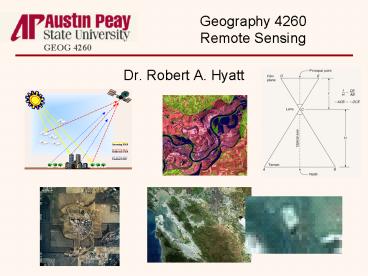Dr' Robert A' Hyatt - PowerPoint PPT Presentation
1 / 23
Title: Dr' Robert A' Hyatt
1
Dr. Robert A. Hyatt
Geography 4260Remote Sensing
GEOG 4260
2
Geography 4260Remote Sensing
GEOG 4260
- Remote Sensing is the science and art acquiring
information about an object without coming into
physical contact with it. - Links to similar definitions of remote sensing
are available on Google.
3
Geography 4260Remote Sensing
GEOG 4260
- Environmental remote sensing is the application
of remote sensing to environmental analysis and
will be the primary consideration of this course.
4
Geography 4260Remote Sensing
GEOG 4260
- Examples of other types of remote sensing
include - Xrays,
- Sonar,
- Gamma-ray remote sensing , and
- Magnetic resonance imaging.
5
Geography 4260Remote Sensing
GEOG 4260
- The most common environmental remote sensing
methods include - Aerial photography,
- Radar remote sensing, and
- Satellite imaging using detectors sensitive to
visible and infrared radiation. - Less common, but becoming more widespread, is
lidar which uses visible light energy in the same
way that radar used microwave radio energy.
6
Geography 4260Remote Sensing
GEOG 4260
- Most methods of environmental remote sensing rely
on some form of electromagnetic radiation to
transmit information about the objects being
studied to the sensor system.
Electromagnetic radiation is a form of energy
that has both electrical and magnetic properties.
7
Geography 4260Remote Sensing
GEOG 4260
- Electromagnetic energy travels through space, and
many forms of electromagnetic energy can also
travel through the atmosphere or even through
solid objects.
8
Geography 4260Remote Sensing
GEOG 4260
- Forms of electromagnetic energy include
- Gamma rays,
- Xrays,
- Ultraviolet light,
- Visible light,
- Infrared light,
- Thermal infrared energy,
- Microwaves, including radar, and
- Ordinary radio waves.
9
Geography 4260Remote Sensing
GEOG 4260
- Although gamma rays, x-rays, ultraviolet light
and radio waves are used in certain forms of
remote sensing, environmental remote sensing is
primarily confined to using visible light,
infrared light, thermal infrared energy and
microwave radio waves. - The topics of this course are confined to
environmental remote sensing.
10
Who is this guy?
GEOG 4260
11
Dr. Bob Hyatt
GEOG 4260
- My qualifications to teach this class include
- A Ph.D. in geography, including training in
geology and physical geography, GIS, cartography,
computer-assisted cartography, remote sensing,
and computer programming, - Considerable teaching experience both as
university professor and as a flight instructor, - Thirteen years of experience in the GIS industry
outside of academia including experience in local
government, environmental consulting, and crime
analysis, and - A wide range of other experiences and interests.
12
Dr. Bob Hyatt
GEOG 4260
- My nomadic tendencies
- I was born in Florida, but raised mostly in
California, North Carolina and Arkansas. - As an adult, I have lived and worked in
California, Hawaii, British Columbia, Iowa,
Georgia, Virginia, North Carolina, and Tennessee. - I have also traveled extensively in the United
States and to a lesser extent in Canada, Mexico
and the Caribbean.
13
Dr. Bob Hyatt
GEOG 4260
- High school
- Yellville-Summit High School, Yellville,
Arkansas. - GPA 2.2.
- Class Rank 24 out of 36.
14
Dr. Bob Hyatt
GEOG 4260
- Employment before and during college
- US Navy. Served in California, Hawaii, Taiwan,
The Philippines and Vietnam. - Residential floor maintenance.
- Stock Clerk and Delivery Boy.
- Taxi Driver.
- FAA-Certified Flight Instructor.
15
Dr. Bob Hyatt
GEOG 4260
- College education
- Los Angeles Pierce Community College.
- B.A., California State University, Northridge,
California, 1976. - M.A., Simon Fraser University, Burnaby, British
Columbia, 1978. - University of Iowa, Iowa City, Iowa.
- PhD, University of Georgia, Athens, Georgia.
16
Dr. Bob Hyatt
GEOG 4260
- Professional career
- Assistant Professor of Geography, Radford
University, Radford, VA. - Geographic Information Systems (GIS) Specialist
- GIS Consulting.
- Local Government.
- Engineering/Environmental Consulting.
- Crime Research.
- Associate Professor of Geography, APSU.
17
GEOG 4260
- Remote Sensing in the Geosciences Curriculum
18
Course Syllabus
GEOG 4260
- The School of Agriculture and Geosciences at APSU
offers a Bachelor of Science Degree in
Geosciences with any one of four concentrations
including the Geographic Information Analysis
Concentration and the Soil and Water Management
Concentration, both of which require this course. - Remote Sensing is also a required course for the
Geographic Information Analysis Minor.
19
Course Syllabus
GEOG 4260
- Remote Sensing is a methodology, however, that is
useful outside of the geosciences. It has
applications in agriculture, biology,
engineering, surveying, urban planning and many
other disciplines.
20
Course Syllabus
GEOG 4260
- Course Syllabus
- Contact Information.
- Course Description/Objectives.
- Course Schedule.
- Course Requirements/Grading.
- Classroom Manners.
- University Policies.
- Tips for success.
- Caveat.
21
Course Syllabus
GEOG 4260
- Web Site
- Contact information,
- Daily schedule,
- Course listings,
- Announcements,
- Course syllabus, and
- Lecture notes with printing instructions.
22
Assignment
GEOG 4260
- Assignment
- Get your textbook,
- Read Chapter 1 in your textbook, and
- Be in class prepared to discuss the contents of
Chapter 1.
23
Questions?
Geography 4260Remote Sensing
GEOG 4260































